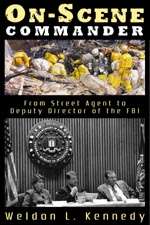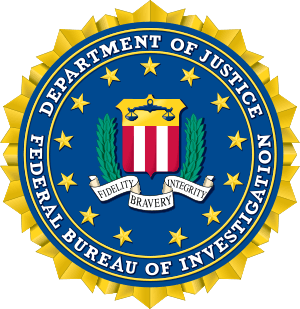Weldon L. Kennedy
Weldon Lynn Kennedy (born September 12, 1938) was a special agent for the Federal Bureau of Investigation and served for 33 years. He is known for negotiating a peaceful end to the Atlanta Prison Riots and his involvement in the investigation of the Oklahoma City bombing. He retired as the FBI's No. 2 in command, Deputy Director, in 1997.
History

Weldon was born in September 1938 in Menlow, Texas, a small community in Hill County that no longer exists.[1][2] After service as an officer in the United States Navy's Office of Naval Intelligence, Weldon joined the FBI in 1963. In 1987, he earned fame as the special agent in charge during a riot at United States Penitentiary, Atlanta, where he negotiated a 13-day takeover. He then acted as Special Agent in charge of the arrests and investigation of Timothy McVeigh and Terry Nichols of the Oklahoma City bombing. In 1995, he was appointed Deputy Director by Louis J. Freeh. In 1997, Kennedy retired and left his office to William Esposito, but only for a few months. Thomas J. Pickard assumed the office officially after Esposito. Kennedy was then hired as Vice Chairman of Guardsmark by Ira A. Lipman. He now resides with his family in Prescott, Arizona. His memoir, On-Scene Commander: From Street Agent to Deputy Director of the FBI, was published by Potomac Books, Inc. on 10 September 2007.[3]
FBI
On July 22, 1963, Weldon began training for the FBI in Washington, D.C. After spending one night in D.C., Weldon was transported by bus to the FBI Academy at Quantico Marine Base in Quantico, Virginia where he received basic training for the FBI. During sixteen weeks of basic training, Weldon and his fellow trainees were bussed back and forth between Quantico, Virginia and Washington, D.C. every few weeks in order to receive hands on training in Washington. While Weldon was receiving FBI training, his wife, Kathy, and their son stayed in Texas at Weldon’s parents’ house and also at Kathy’s parents house.[4]
Weldon’s involvement in the Atlanta Prison Riots
On Monday, November 23, 1987, prisoners of the United States Penitentiary in Atlanta, Georgia began rioting in reaction to recent news from Cuba. It had been announced that President Fidel Castro would allow certain Cubans who traveled to the United States during the 1980 Mariel boat lift, to return to Cuba. The Cubans that were allowed to return were individuals that broke laws in the United States, or came to the U.S. with pre-existing mental disorders or criminal records. Many inmates in Atlanta claimed that they would prefer death over the return to Cuba. As many of the Cuban inmates were thought to have served in the Cuban military, there was organization involved in the riot that led to over thirty prison guards being held as hostages by the prisoners. Along with hostages being taken, the inmates also started multiple fires throughout the penitentiary while rioting.[5]
Weldon L. Kennedy was the leader of the FBI in Atlanta, Georgia at the time of the Atlanta prison riots. In order to end the prison riots peacefully, Weldon had to be extremely careful with every decision he made; especially because prison guards were being held hostage. While interacting with the prisoners, Weldon and his team learned that the Cuban prisoners wanted outside negotiators that they could trust brought in to the prison. Weldon listened to the prisoners’ demands and brought into the prison, Auxiliary Bishop Augustin Roman of Miami and a group of American Civil Liberties Union lawyers who had sympathized with the Cuban prisoners in the past. After Weldon explained to both outsider parties what role they would play and how they were supposed to act, Weldon was able to conduct a peaceful end to the prison riots.[6]
References
- ↑ "Menlow, Texas". Handbook of Texas Online. Texas State Historical Association. 2008-01-18. Retrieved 2008-11-23.
- ↑ McKenzie, Kevin (16 March 1997). "Veteran FBI Agent Finds Security at Guardsmark". Memphis Commercial Appeal. E. W. Scripps Company.
- ↑ "On-Scene Commander: From Street Agent to Deputy Director of the FBI". Potomac Books, Inc. Retrieved 2007-05-30.
- ↑ Weldon L. Kennedy, On-scene Commander from Street Agent to Deputy Director of the FBI, Washington, D.C.: Potomac Books, 2007, 19-20.
- ↑ George de Lama, Chicago Tribune, Tribune correspondent Mary T Schmich in Oakdale, La, contributed to this story, "CUBAN RIOTS HIT 2D U.S. PRISON SCORES HELD HOSTAGE IN ATLANTA SIEGE," Chicago Tribune (Pre-1997 Fulltext), Nov 24, 1987.
- ↑ Weldon L. Kennedy, On-scene Commander from Street Agent to Deputy Director of the FBI, Washington, D.C.: Potomac Books, 2007, 145-148.
| Government offices | ||
|---|---|---|
| Preceded by Larry A. Potts |
Deputy Director of the Federal Bureau of Investigation 1995–1997 |
Succeeded by William Esposito |
